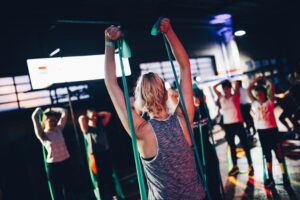Mastering The Art Of Back Exercises: Your Key To a Sculpted Upper Body
A strong back is not only eye-pleasing but also essential for overall fitness and well-being. While many people concentrate on developing their arms, legs, and chest, neglecting the back muscles can result in muscular imbalances and issues with posture.
Since our back consists of several key muscles, each muscle group plays a unique role in back movement and stability. So it becomes essential for both men and women to engage in back exercises to yield numerous benefits.
From improved posture and reduced risk of back pain to enhanced performance in daily activities. A strong back helps reduce the likelihood of back pain and injuries by providing stability and support to the spine during movements and activities, which is essential, especially in old age.
Today, we will talk about the importance of having strong back muscles, the advantages it offers, key exercises that can strengthen the back, how you can incorporate back exercises into a full-body workout routine, and common mistakes you need to avoid. I am going to provide a few tips for recovery and injury prevention while working on your back.
Let’s start with the significance of a strong back:
Support and Stability:
A strong back provides support for the spine, improving posture and minimizing the risk of postural issues and related discomfort.
Functional Strength and Performance:
Back muscles contribute to everyday movements, such as lifting, carrying, and pulling, enhancing overall functional strength and performance.
Injury Prevention:
Developing strong back muscles helps protect against back injuries by providing stability during physical activities and reducing strain on the spine.
Now let’s talk about the benefits that come with having strong back muscles:
Posture and Alignment:
Posture and spinal support are crucial for maintaining a healthy and pain-free spine. Good posture helps distribute the forces exerted on the spine evenly, reducing the risk of strain and injury. Strong back muscles help maintain proper posture, and alignment of the body parts, particularly the spine. It also reduces the risk of musculoskeletal problems.
Injury Prevention:
A strong back provides stability and support to the spine, reducing the risk of back injuries during physical activities and sports. It supports the core and helps with proper lifting techniques, reducing strain on the lower back during activities like lifting heavy objects or performing physical tasks.
Improved Core Stability
The core is made up of the back muscles and the abdominal muscles. Strengthening the back muscles improves core stability and helps to maintain a solid foundation for movement.
Functional Strength:
A strong back helps with everyday movements like bending, twisting, pulling, and pushing. Strong back muscles contribute to overall strength, making daily tasks such as lifting objects, carrying groceries, and performing chores easier to handle.
Now, let’s take a look at some key back muscle exercises:
Deadlifts:
A compound exercise that primarily targets your lower back but also engages your glutes, hamstrings, and upper back, deadlifts are a great way to get a good workout. They are fantastic for increasing overall back strength and promoting proper posture.
Bent-Over Rows:
Bent-over rows target your middle and upper back muscles, including the rhomboids, trapezius, and rear deltoids. This exercise helps improve posture, upper body strength, and muscle definition.
Lat Pulldowns/Pull-Ups:
Lat pulldowns and pull-ups primarily target your latissimus dorsi muscles (lats), which are responsible for the width and V-shape appearance of your back. These exercises also engage your biceps, rear deltoids, and other supporting muscles.
Seated Cable Rows:
Seated cable rows engage multiple muscles in your back, including the lats, rhomboids, rear delts, and lower traps. They are effective for building overall back thickness and strength.
Reverse Flyes:
Reverse flyes target your rear deltoids and help balance out your shoulder development. These exercises improve posture and contribute to an aesthetically pleasing back.
Back Extensions:
Back extensions primarily target your lower back muscles and are effective for strengthening your spinal erectors. This exercise can help alleviate lower back pain and improve posture.
Hyperextensions:
Hyperextensions work your lower back, glutes, and hamstrings. They help strengthen your posterior chain and promote overall back stability.
Cable Face Pulls:
Cable face pulls target your rear deltoids, rhomboids, and rotator cuff muscles. They are beneficial for improving shoulder health, posture, and upper back development.
Shrugs:
Shrugs primarily target your trapezius muscles, which are responsible for lifting and retracting your shoulders. They help develop upper back strength and improve shoulder stability.
Tips that you need to incorporate into a full-body workout :
Schedule Back Days:
Designate specific days in your training routine solely for back exercises. For example, you can have a dedicated back day where you focus on back-specific exercises. Alternatively, you can incorporate back exercises into upper-body or full-body workouts, ensuring overall muscle development.
Balance Push and Pull:
Ensure a balanced workout routine by pairing back exercises with chest exercises. While exercises like bench presses and push-ups target the pushing muscles, incorporating pull exercises, such as rows and lat pulldowns, will help strengthen the pulling muscles and maintain muscle symmetry.
Superset Opposing Muscles:
Combine back exercises with exercises that target opposing muscle groups, such as the chest or abs. Including these exercises in your routine ensures that you work your back muscles along with other major muscle groups, resulting in a balanced and efficient workout.
Mistakes that you need to avoid when performing back exercises:
Neglecting Proper Form:
Incorrect form during back exercises can lead to ineffective workouts and potential injuries. It is crucial to maintain proper spinal alignment, engage the targeted muscles, and use controlled movements throughout the exercise.
Relying Exclusively on Machines:
While machines can be useful for certain exercises, relying solely on them may limit the engagement of stabilizing muscles. Incorporating free weights and bodyweight exercises can provide a more functional and comprehensive workout.
Overtraining or neglecting rest:
Giving your muscles sufficient time to recover and grow is essential. Overtraining the back muscles can lead to fatigue, decreased performance, and an increased risk of injury. Incorporate rest days into your workout routine and listen to your body’s signals.
Some tips for injury recovery and prevention:
Rest and Recovery:
Allow sufficient rest between back workouts to promote muscle recovery and growth. Aim for 48 hours of recovery before working the same muscle group again.
Proper Warm-up and Cool-down:
Prioritize a warm-up routine that includes dynamic stretches and movements to prepare the back muscles for exercise. Similarly, cooling down with static stretches and foam rolling can aid in recovery and prevent post-workout muscle stiffness. This is the area that I mostly neglect during my workouts.
Stretching and Mobility:
Including stretching and mobility exercises, such as cat-cow stretches, cobra poses, and thoracic rotations, can help improve flexibility, reduce muscle tension, and prevent injuries in the back and surrounding areas.
Gradual Progression:
Gradually increasing the intensity, volume, or complexity of your back exercises over time can promote continuous improvement. Incorporating variations of back exercises and regularly challenging your muscles in different ways can prevent plateaus and keep your workouts engaging.
Final Words on Back Exercises:
A strong back is a fundamental component of overall fitness and vitality. Incorporating targeted back exercises into your workout routine not only improves posture and functional movement but also enhances core stability, athletic performance, and functional strength.
If you are new to back exercises, start with lighter weights and gradually increase the load as you become more comfortable and stronger. Always listen to your body and choose weights that challenge you while maintaining proper form and technique.
It’s also important to warm up properly and stretch before and after your workout to prevent injuries and promote flexibility.
Remember, consistency and patience are keys to achieving long-term results. The benefits of a strong back extend beyond the gym walls and into your everyday life. Embrace the challenge, stay disciplined, and watch as your back becomes a pillar of strength and support in your pursuit of a healthy and active lifestyle.


You May Also Like

The Truth About Chest Workouts for Women: Separating Fact from Fiction
22 September 2023
Top 5 Chest Workouts for Women
27 June 2023



